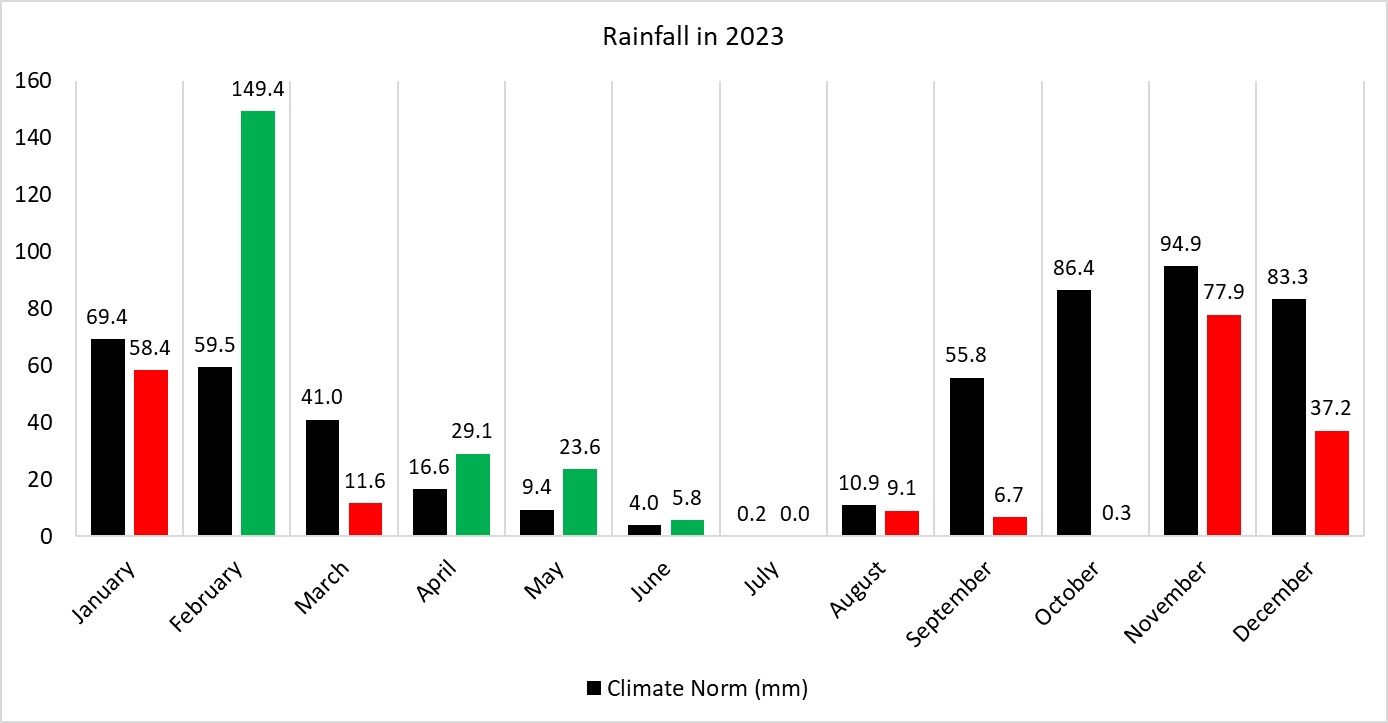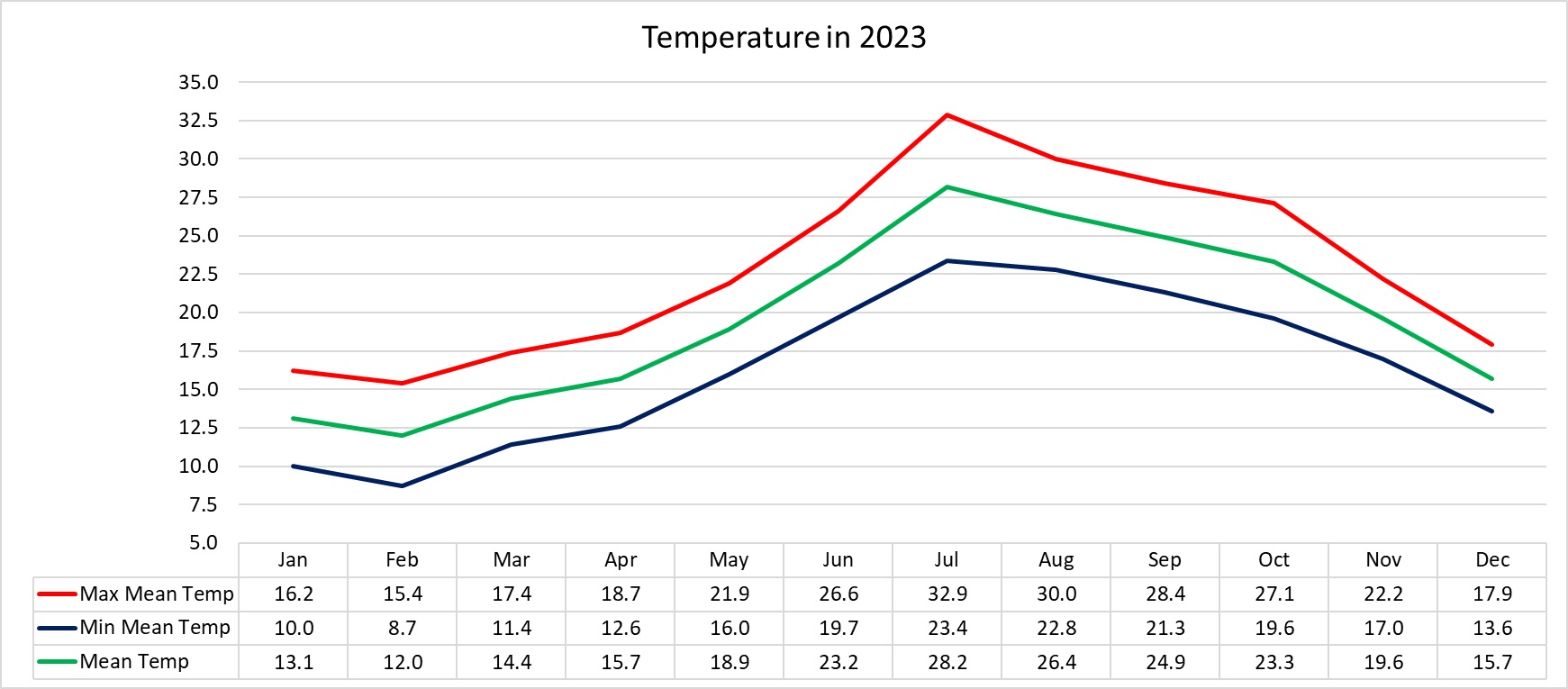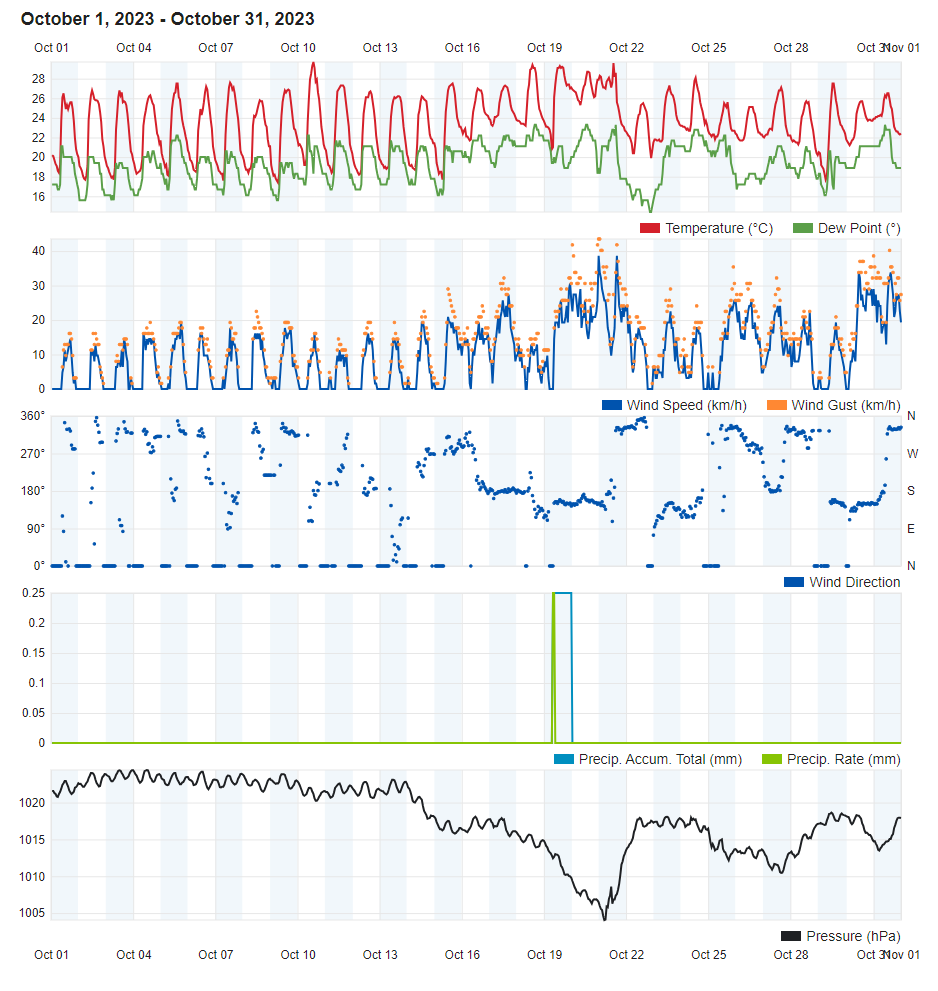Air Temperature
| Highest Maximum |
39.8°C |
24th July 2023 |
| Lowest Maximum |
10.6°C |
8th February 2023 |
| Highest Minimum |
28.5°C |
25th July 2023 |
| Lowest Minimum |
4.9°C |
24th January 2023 |
| Mean Maximum |
22.9°C |
| Mean Minimum |
16.3°C |
| Mean |
19.6°C |
Relative Humidity
| Mean Relative Humidity |
77.4% |
Atmospheric Pressure
| Highest Atmospheric Pressure |
1034.0hPa |
14th February 2023 |
| Lowest Atmospheric Pressure |
996.5hPa |
25th November 2023 |
| Mean Atmospheric Pressure |
1016.6hPa |
Wind
| Highest Gust |
67.6 km/h (Force 8) |
10th January 2023 |
| Mean Wind Speed |
10.4 km/h |
| Most Frequent Wind Direction |
West Southwest |
Precipitation
| Total Rainfall During 2023 |
409.1 mm |
| Highest 24 Hour Total |
121.1 mm |
9th February 2023 |
| Rain Days |
66 days |
| Thunderstorm Days |
26 days |
| Hail Days |
9 days |
Rainfall Events
| 01/01/2023 |
0.3 mm |
Dew |
| 02/01/2023 |
0.2 mm |
Light Rain |
| 03/01/2023 |
0.3 mm |
Light Rain |
| 09/01/2023 |
2.8 mm |
Rain and Hail Showers |
| 10/01/2023 |
0.8 mm |
Rain Showers |
| 12/01/2023 |
1.8 mm |
Light Rain |
| 19/01/2023 |
1.3 mm |
Rain Showers; Distant Thunder |
| 20/01/2023 |
3.1 mm |
A.M. Thunderstorm with Hail |
| 21/01/2023 |
0.5 mm |
Light Rain |
| 22/01/2023 |
9.3 mm |
Showers and Thunderstorms with Hail |
| 24/01/2023 |
9.3 mm |
Steady Rain; Distant Thunder |
| 25/01/2023 |
0.8 mm |
A.M. Light Rain; Distant Thunder |
| 26/01/2023 |
9.8 mm |
Thunderstorm with Hail |
| 27/01/2023 |
9.8 mm |
Thunderstorm; Rain and Hail Showers |
| 28/01/2023 |
8.3 mm |
Thunderstorm with Hail; Showers |
| 29/01/2023 |
0.0 mm |
Distant Thunder and Hail |
| 02/02/2023 |
1.1 mm |
Light Rain |
| 07/02/2023 |
3.0 mm |
Light Rain |
| 08/02/2023 |
18.7 mm |
P.M. Steady Rain |
| 09/02/2023 |
121.1 mm |
Steady Rain; Thunderstorms |
| 10/02/2023 |
2.5 mm |
A.M. Steady Rain; Distant Thunder and Hail |
| 13/02/2023 |
1.5 mm |
Light Rain |
| 14/02/2023 |
0.5 mm |
Light Rain |
| 21/02/2023 |
0.3 mm |
Dew; Fog |
| 22/02/2023 |
0.2 mm |
Dew; Fog |
| 23/02/2023 |
0.3 mm |
Dew; Fog |
| 24/02/2023 |
0.2 mm |
Dew; Fog |
| 02/03/2023 |
7.5 mm |
Thunderstorm with Hail |
| 03/03/2023 |
4.1 mm |
Showers |
| 02/04/2023 |
15.8 mm |
P.M. Rainy |
| 03/04/2023 |
4.2 mm |
A.M. Showers |
| 05/04/2023 |
0.3 mm |
Light Rain; Distant Thunder |
| 16/04/2023 |
8.8 mm |
Rainy |
| 02/05/2023 |
0.0 mm |
Distant Showers |
| 07/05/2023 |
0.0 mm |
Fog |
| 08/05/2023 |
1.0 mm |
Light Rain |
| 09/05/2023 |
2.4 mm |
Light Rain |
| 11/05/2023 |
0.0 mm |
Mist |
| 12/05/2023 |
0.5 mm |
Light Rain |
| 13/05/2023 |
1.9 mm |
Light Rain; Distant Thunder |
| 14/05/2023 |
0.0 mm |
Haze |
| 15/05/2023 |
4.0 mm |
Thunderstorm |
| 16/05/2023 |
0.0 mm |
Distant Showers |
| 19/05/2023 |
0.0 mm |
Distant Showers |
| 20/05/2023 |
0.0 mm |
Haze; Widespread Dust |
| 21/05/2023 |
13.8 mm |
Thunderstorm |
| 22/05/2023 |
0.0 mm |
Distant Showers |
| 25/05/2023 |
0.0 mm |
Distant Thunder |
| 26/05/2023 |
0.0 mm |
Distant Showers |
| 28/05/2023 |
0.0 mm |
Fog |
| 29/05/2023 |
0.0 mm |
Fog |
| 30/05/2023 |
0.0 mm |
Haze |
| 02/06/2023 |
0.0 mm |
Distant Showers |
| 05/06/2023 |
1.8 mm |
Thunderstorm |
| 06/06/2023 |
2.4 mm |
Thunderstorm |
| 10/06/2023 |
1.3 mm |
Showers |
| 11/06/2023 |
0.3 mm |
Light Rain |
| 19/06/2023 |
0.0 mm |
Fog |
| 30/06/2023 |
0.0 mm |
Fog |
| 21/08/2023 |
9.1 mm |
Thunderstorm |
| 31/08/2023 |
0.0 mm |
Distant Thunderstorm |
| 05/09/2023 |
0.5 mm |
Light Rain |
| 06/09/2023 |
0.0 mm |
Distant Rain |
| 07/09/2023 |
3.8 mm |
P.M. Thunderstorm |
| 08/09/2023 |
0.0 mm |
Distant Rain |
| 25/09/2023 |
0.5 mm |
Light Rain |
| 26/09/2023 |
1.9 mm |
Isolated Showers; Distant Thunder |
| 28/09/2023 |
0.0 mm |
Distant Rain |
| 19/10/2023 |
0.3 mm |
Mist/Fog and Dew |
| 04/11/2023 |
8.1 mm |
Showers; Distant Thunder |
| 11/11/2023 |
0.3 mm |
Light Rain |
| 12/11/2023 |
1.2 mm |
Light Rain |
| 22/11/2023 |
31.3 mm |
Thunderstorm |
| 23/11/2023 |
8.8 mm |
Thuderstorms |
| 24/11/2023 |
26.8 mm |
Thunderstorm with Hail |
| 25/11/2023 |
2.4 mm |
Showers |
| 28/11/2023 |
2.3 mm |
Showers |
| 29/11/2023 |
4.8 mm |
Showers |
| 5/12/2023 |
0.3 mm |
Light Rain |
| 6/12/2023 |
0.9 mm |
Light Rain |
| 7/12/2023 |
1.7 mm |
Light Rain |
| 8/12/2023 |
1.3 mm |
Light Rain |
| 9/12/2023 |
9.0 mm |
Showers |
| 10/12/2023 |
0.3 mm |
Light Rain |
| 14/12/2023 |
0.5 mm |
Light Rain |
| 15/12/2023 |
1.0 mm |
Light Rain |
| 16/12/2023 |
0.0 mm |
Distant Thunderstorms and Hail |
| 17/12/2023 |
2.5 mm |
Showers |
| 18/12/2023 |
17.6 mm |
Rainy |
| 20/12/2023 |
1.0 mm |
Light Rain |
| 21/12/2023 |
0.3 mm |
Light Rain |
| 22/12/2023 |
0.8 mm |
Light Rain |
2023 Compared to the Climate Means
| |
Climate Mean |
2023 |
Anomaly |
| Mean Maximum Temperature |
22.9°C |
22.9°C |
/ |
| Mean Minimum Temperature |
16.0°C |
16.3°C |
+0.3°C |
| Mean Temperature |
19.5°C |
19.6°C |
+0.1°C |
| Mean Relative Humidity |
75.7% |
77.4% |
+1.7% |
| Mean Atmospheric Pressure |
1016.5hPa |
1016.6hPa |
+0.1hPa |
| Mean Wind Speed |
14.1 km/h |
10.4 km/h |
-3.7 km/h |
| Most Frequent Wind Direction |
West Northwest |
West Southwest |
-45° |
| Total Rainfall |
531.4 mm |
409.1 mm |
-122.3 mm |
| Total Rain Days |
84 days |
66 days |
-18days |
| Total Thunderstorm Days |
30 days |
26 days |
-4days |
| Total Hail Days |
10 days |
9 days |
-1day |
Month-by-Month Summary for 2023
January 2023 – Warmer and Drier
February 2023 – Colder and Wetter (REGISTERING ONE OF THE WETTEST FEBRUARY DAYS EVER)
March 2023 – Warmer and Drier
April 2023 – Colder and Wetter
May 2023 – Colder and Wetter
June 2023 – Colder and Wetter
July 2023 – Warmer with Average Rainfall (WARMEST ON RECORD) (EQUALLED THE RECORD FOR THE WARMEST JULY DAY EVER) (REGISTERING ONE OF THE WARMEST JULY NIGHTS EVER)
August 2023 – Colder with Average Rainfall
September 2023 – Average Temperature and Drier
October 2023 – Warmer and Drier (WARMEST AND DRIEST ON RECORD) (REGISTERING ONE OF THE WARMEST OCTOBER NIGHTS EVER)
November 2023 – Warmer and Drier (AMONG THE WARMEST ON RECORD) (REGISTERING ONE OF THE WARMEST NOVEMBER DAYS EVER)
December 2023 – Warmer and Drier (REGISTERING ONE OF THE WARMEST DECEMBER DAYS EVER)
2023: The Year of Storm Helios and Heatwave Cerberus
2023 was a year that saw long-standing temperature and precipitation records fall. Numerous phenomena worth mentioning were observed.
Overall, 2023 was only a fraction of a degree warmer than the climate norm. There’s more to it than meets the eye, however. A cooler than average first half of the year ended up balancing out a warmer than average second half of the year. The greatest difference from the climate mean was registered in minimum temperatures. With a mean minimum temperature of 16.3˚C, nights in 2023 were overall 0.3˚C warmer. If we look at 2023 from a month-by-month point of view, however, we notice that it was indeed a year of two faces. Four of the first six months (February, April, May and June) were colder than average. 2023 started off with bright sunshine, warm temperatures and calm. This was the product of a persistent anticyclone that had covered the central Mediterranean since the start of meteorological winter. The anticyclone faded away slowly, with the second week of January 2023 registering the first gale of the year. An abrupt cold snap bringing typical wintry weather started overnight on the 19th and lasted till the end of the month. This was the result of deep low pressure extending from mainland Europe towards the Mediterranean. It brought colder temperatures and eleven consecutive days with at least one shower being recorded at some point during the day. The year’s coldest night was to be that of January 24th. The mercury that night dipped to a chilly 4.9°C. February’s mean minimum temperature was also calculated at a chilly 8.7°C. February 2023 proved to be a very eventful one too. 149.4 mm of rain were measured over the course of last February. 95% of this were measured in a staggering 35 hours of incessant rainfall from later in the afternoon on the 8th through to the predawn hours of the 10th. The 9th will be remembered for being the wettest February day on record. This was produced by Storm Helios, an intense Mediterranean cyclone which developed over the central Mediterranean. These 35 hours of intense rainfall also accounted for the two days of thunder and one day of hail recorded last month. The rest of the month was relatively stable. Persistent anticyclonic conditions that encompassed much of March proved to be a false spring. The months of April through to June were characterized by colder and wetter conditions. Unseasonal anticyclones persisted over the British Isles and Scandinavia throughout the month, deflecting zones of instability towards our region of the Mediterranean. This instability brought with it frequent blasts of colder air from the north, allowing temperatures to remain colder than average throughout, especially during daylight hours. The fact that showers persisted into the first half of June had a noticeable impact on most meteorological parameters. The rain recharged the soil with moisture. Subsequent sunshine evaporated this, elevating levels of humidity. In fact, relative humidity was a staggering 10% higher than the norm during spring. This prevented air temperatures from soaring to extreme levels early in the season In fact, no heat spells were registered till the end of June. The rain was also heavy enough to cause runoff from roads and valleys. This created an influx of colder fresh water in most bays, cooling down the sea slightly. The late showers also had a visible impact on vegetation. Wild small trees and bushes were given that much-needed boost of surface water ahead of the dry season. Mature trees would utilize this later on in the season. June 2023 was in fact a breath of fresh air from the previous two record-breaking Junes.
It didn’t take long for this state of affairs to change, however. Mean temperatures in Malta in July were overall a staggering 3.5°C over the climate average. This made it officially the hottest July on record. This was down to an intense heat wave dubbed Cerberus. Lasting from 16th July through to 25th July (both days included), it proved to be record-breaking too. Whilst the temperature peaked at 39.8°C across Gozo, the maximum temperature across central Malta spiked to 42.7°C on the 24th. This was the joint hottest temperature measured during July along with the record set back on 9th July 1988. A deeper look into readings from central Malta show how the air temperature exceeded 40°C on a record-breaking six consecutive days. These are 41.0°C on the 20th, 40.2°C on the 21st, 41.1°C on the 22nd, 42.3°C on the 23rd, 42.7°C on the 24th and 40.0°C on the 25th. July’s long-lasting heat wave also broke the record for the warmest night. The minimum temperature on the night between the 24th and 25th remained at a hot 30.6°C at the airport. This heatwave occurred as a result of a heat dome. A heat dome is a phenomenon in which high-pressure atmospheric conditions trap air coming in from the Sahara Desert. The trapped air heats up at an alarming rate as it is compressed, like what happens under the lid on a saucepan. In normal conditions, winds are able to move a heat dome around, but because this particular heat dome stretched high into the atmosphere, it wasn’t easy to move about. This led to the persistent heatwave. The heat dome caused air pollution, desert sand and moisture to become stagnant, leading to a choked up atmosphere. August 2023 proved a breath of fresh air for the Maltese Islands as no heat waves were experienced and temperatures were not as intense. August 2023 also brought about two separate rainfall events.
Autumn 2023 was to be an overall disappointing affair. There were two distinct episodes of instability during September 2023. The first was the one associated with Storm ‘Daniel’ from the 5th through to the 9th whilst the next was on the 25th and 26th. Both missed the Maltese Islands by a whisker. The former caused a natural disaster on Libyan shores. The second month of meteorological autumn, October 2023, was the warmest in decades and the driest in a century. A spell of very warm temperatures was also recorded from the 18th till the 21st. Temperature values at the MetOffice in Malta International Airport were warm enough to be classified as a heatwave. The night from the 19th through to the 20th broke the record for the warmest October night on record. This was down to an anticyclone which spanned much of the Mediterranean and persisted for weeks. The first half of November 2023 brought very warm temperatures to the Maltese Islands. The first day of November was the hottest day of the month ever recorded. This was accompanied by the continuation of a shortage of rain that had gripped the Maltese Islands throughout October. The situation took a more seasonal turn as November came to a close. Temperatures cooled down and precipitation returned to our shores, bringing the first widespread rainfall since springtime. The 86.0 mm of rainfall measured that month fell just short of the climate mean. This seasonal state of affairs was to be short-lived, however. December 2023, the final month of the year and the first month of the meteorological winter, continued the trend of warmer and drier than average weather set by previous months. There were only three episodes of instability; one at the start of the month, another halfway through the month and another just before Christmas Day.










 Rainfall Totals around the Maltese Islands in January 2024 (and since last September 1st):
Rainfall Totals around the Maltese Islands in January 2024 (and since last September 1st):




